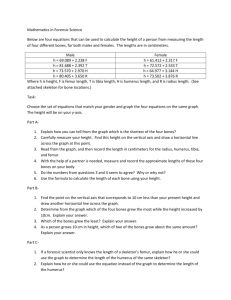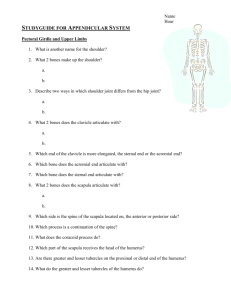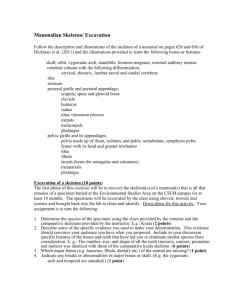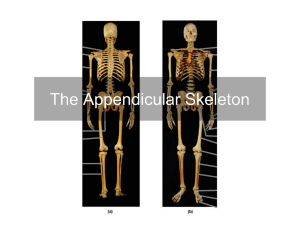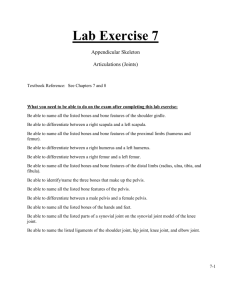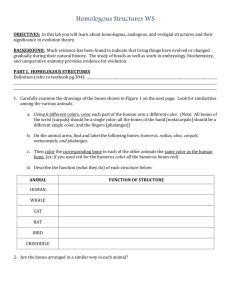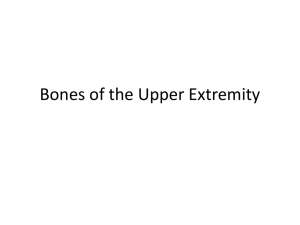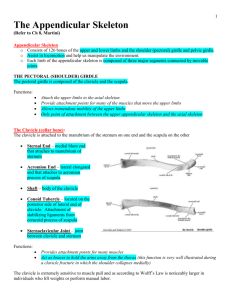The Appendicular Skeleton
advertisement
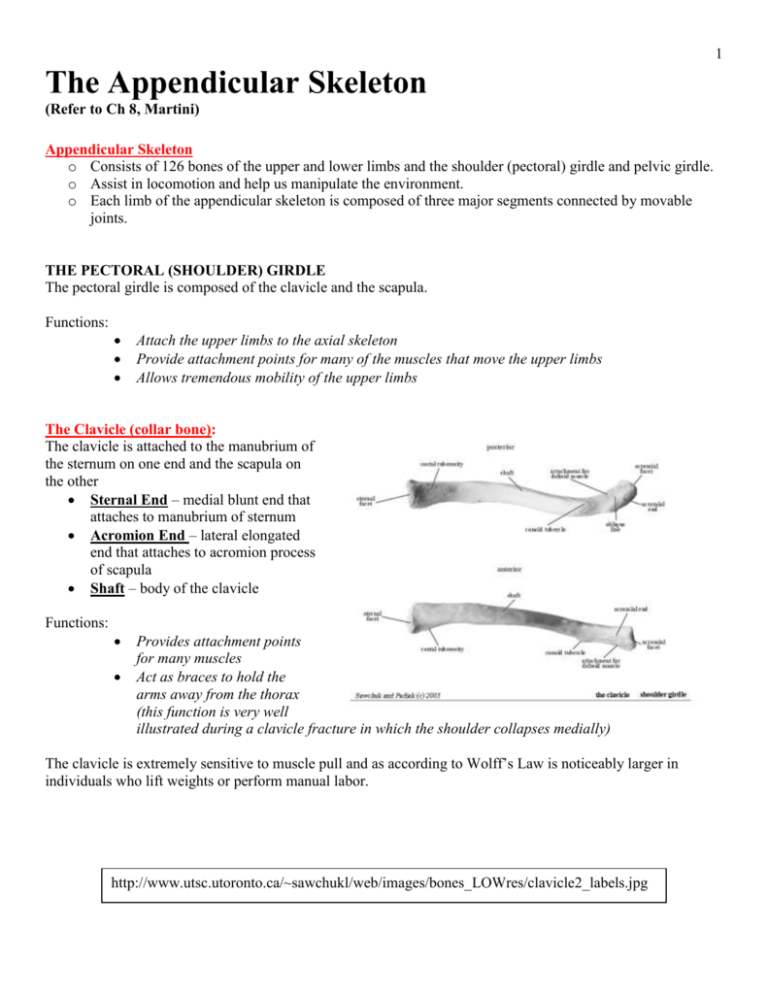
1 The Appendicular Skeleton (Refer to Ch 8, Martini) Appendicular Skeleton o Consists of 126 bones of the upper and lower limbs and the shoulder (pectoral) girdle and pelvic girdle. o Assist in locomotion and help us manipulate the environment. o Each limb of the appendicular skeleton is composed of three major segments connected by movable joints. THE PECTORAL (SHOULDER) GIRDLE The pectoral girdle is composed of the clavicle and the scapula. Functions: Attach the upper limbs to the axial skeleton Provide attachment points for many of the muscles that move the upper limbs Allows tremendous mobility of the upper limbs The Clavicle (collar bone): The clavicle is attached to the manubrium of the sternum on one end and the scapula on the other Sternal End – medial blunt end that attaches to manubrium of sternum Acromion End – lateral elongated end that attaches to acromion process of scapula Shaft – body of the clavicle Functions: Provides attachment points for many muscles Act as braces to hold the arms away from the thorax (this function is very well illustrated during a clavicle fracture in which the shoulder collapses medially) The clavicle is extremely sensitive to muscle pull and as according to Wolff’s Law is noticeably larger in individuals who lift weights or perform manual labor. http://www.utsc.utoronto.ca/~sawchukl/web/images/bones_LOWres/clavicle2_labels.jpg 2 Superior Border The Scapula (shoulder blades): acromion process - enlarged end of the spine of the scapula that connects the clavicle as well as several muscles coracoid process - points over the top of the shoulder and anchors the clavicle and some of the muscles of the arm. glenoid cavity - a shallow socket that receives the head of the humerus. (Vertebral) (Axillary) Scapular Spine – ridge along the posterior aspect of the scapula The pectoral girdle has exceptional range of motion due to only one attachment to the axial skeleton and a shallow ball-and-socket joint that is poorly reinforced by ligaments. In comparison to the hip joint, the pectoral girdle has exceptional flexibility but is very easily dislocated. THE UPPER LIMBS There are 30 bones per upper limb, humerus through the phalanges. The Humerus (upper arm): Characteristics of the humerus: The proximal end (head) of the humerus fits into the shallow glenoid cavity. Greater tubercles and lesser tubercles - sites of muscle attachment on proximal end of humerus Deltoid tuberosity - point of attachment for the deltoid muscle along the midpoint of the shaft The medial trochlea and the lateral capitulum are located at the distal end of the humerus and articulate with the bones of the forearm. Coronoid fossa and the olecranon fossa – found at the distal end of the humerus - allow the processes of the ulna to move freely when the elbow is bent and extended. Also know head, surgical neck, anatomical neck, intertubicular groove, medial epicondyle, lateral epicondyle, and radial fossa 3 The Radius and Ulna (forearm): ULNA: forms elbow with the humerus and is found on the little finger side of the wrist. Coronoid process - on anterior proximal side Olecranon process –posterior proximal side o Together these processes grip trochlea of the humerus in a pliers-like joint. Trochlear (semilunar) notch – separates the coronoid and olecranon processes; articulates with the trochlea of humerus Also know head, radial notch, distal radialulnar joint, styloid process, and ulnar tuberosity RADIUS: the bone with the most responsibility to carry the wrist. head of radius: located on proximal end of radius; articulates with capitulum of humerus radial tuberosity –just below the head of the radius; where biceps tendon attaches. Also know neck and styloid process http://www2.ma.psu.edu/~pt/384fore1.gif The Carpals, Metacarpals, and Phalanges (hand): http://www2.ma.psu.edu/~pt/handbon.gif There are 8 marble sized short bones called the carpals, which are arranged in two rows of four bones and form the carpus (wrist). Each of these bones has an individual name. The 5 metacarpals form the palm if the hand. These long bones are not named, but are numbered 1 to 5 from the thumb to the little finger. The heads of these bones form your knuckles when you clench your fist. Metacarpal #1 is associated with your thumb and has the most flexibility and even a different type of joint for attachment. This allows your thumb to be used in opposition (the opposing thumb) to your other fingers. There are 14 miniature long bones called the phalanges that make up the human fingers. Each finger has 3 phalanges, except for the thumb (pollex) which has 2. The names of the three phalanges are proximal, middle, and distal. (Phalanx is the singular term for phalanges.) 4 THE PELVIC GIRDLE (HIP) Functions: Attaches the lower limbs to the lower end of the axial skeleton Transmits the weight of the upper body to the lower limbs Provides a surface for muscles to attach Supports the visceral (internal) organs of the pelvis Firmly holds the head of the femur, using a deep socket and some of the strongest ligaments in the body A pair of irregularly shaped hipbones called the coxal bones forms the pelvic girdle. During childhood the coxal bones consist of three individual bones that fuse by adulthood. The three individual bones are the ilium, ischium, and pubis. The Ilium: The ilium is the largest bone of the pelvis. sacroiliac joint – where the sacrum and ilium join iliac crest.- superior edge of the ilium anterior superior iliac crest The Ischium: The ischium (is’ke-um) forms the most inferior part of the coxal bone. ischial tuberosity - receives the body weight when sitting. ischial spine - a protrusion that narrows the outlet of the pelvis where the baby must pass during child birth greater sciatic notch - allows blood vessels and the sciatic nerve to pass through the pelvis into the thigh. The Pubis: The pubis fuses with the ischium to form a bar of bone enclosing the obturator foramen. obturator foramen - allows blood vessels and nerves to pass into the anterior part of the thigh. pubic symphysis – cartilage joint formed where bones of the pelvis fuse The ilium, ischium, and pubis fuse at the acetabulum, the deep socket that receives the head of the femur. Also know pubic crest, pubic ramus, ischial ramus, anterior superior iliac spine, and pubic arch 5 The pelvis provides an easy way to distinguish between the skeletons of a male and a female. The female pelvis reflects modifications for childbearing. In comparison to the male pelvis, the female pelvis: Wider Rounder Shallower Lighter In addition, the inlet and outlet of the female are larger and more circular and the sacrum is shorter/less curved. True Pelvis – opening inside of coxal bones False Pelvis – outside of coxal bones THE LOWER LIMBS Functions: Carry the weight of the entire upper body Provides attachment for the muscles of the legs The Femur (thigh): Largest, longest, & strongest bone in the body (length is roughly ¼ of a person’s height) head – proximal end that fits in acetabulum of coxal bone fovea capitis – small pit in the center of the femoral head (ligament attaches to acetabulum) neck - supports head – weakest area of the femur greater trochanter - attachment for buttocks & thigh muscles lesser trochanter - attachment for buttocks & thigh muscles intertrochanteric crest – separates greater and lesser trochanters lateral epicondyles – located on lateral distal end of femur; attachment for large muscles medial epicondyles - located on medial distal end of femur; attachment for large muscles lateral condyles - lateral distal femur; articulates with tibia medial condyles - located on medial distal end of femur; articulates with tibia gluteal tuberosity – located on diaphysis; attachment for gluteal muscles intercondylar fossa – depression between condyles 6 The Patella (knee): A sesamoid bone enclosed in the quadriceps tendon that secures the thigh muscles to the tibia. The Tibia and Fibula ( lower leg): The tibia and fibula are much less flexible yet more stable than the ulna and radius of the forearm. The tibia (shinbone) forms the knee joint with the femur, and also forms the ankle joint with the bones of he foot. The tibia can be felt through the thin layer of skin for the entire length of the lower leg. It is only second to the femur in strength and size. lateral condyles – located at the lateral proximal end of the tibia; articulates with the femur medial condyles - located at the medial proximal end of the tibia; articulates with the femur intercondylar eminence – separates the medial and lateral condyles of the tibia tibial tuberosity – located on the anterior tibial surface; anchor point for the patellar ligament medial malleolus – forms the inner bulge of the ankle anterior crest – sharp ridge along the anterior crest of the tibia (shin) The fibula only provides support for the ankle and does not assist in the joint of the knee. The fibula does not bear weight, but does have many muscles attached to it. Lateral malleolus - located on the distal end of the fibula; forms the outer bulge of the ankle. Also know inferior articular surface of tibia, malleolar articular surface of tibia and fibula, and head and neck of fibula 7 The Tarsals, Metatarsals, and Phalanges (foot): Functions of the Foot: Supports our body weight Acts as a lever to propel our body forward as we walk or run If we had only one bone in our foot, we could still propel our body in the same fashion, however, we would not be able to adapt so well to uneven ground. The tarsas (ankle) is composed of 7 tarsals that are more irregular shaped than the carpals, and there are more size differences among them. (Refer to page 141) Most of the body weight is carried on the largest two tarsals, the calcaneus (heel bone) and the talus (lies between tibia and calcaneus). The metatarsals are composed of 5 small long bones. They are not named, but are numbered 1 to 5 beginning with the big toe side of the foot. #1 is the shortest and thickest metatarsal. http://www.icbmedical.com/__data/page/104 /Foot-Bone-Structure3.gif The 14 phalanges of the toes are much smaller than those of the fingers. There are three phalanges within each toe except the big toe. The phalanges of each toe are proximal, middle, and distal, with the big toe missing the middle phalanx. Arches The bones in the foot are arranged to form three arches; two longitudinal (medial and lateral) and one transverse (Refer to Figure 5.24). The ligaments and tendons of the foot hold the bones in place and allow a certain amount of give to maintain the arches. http://www.slackbooks.com/excerpts/34914/10-3.gif
